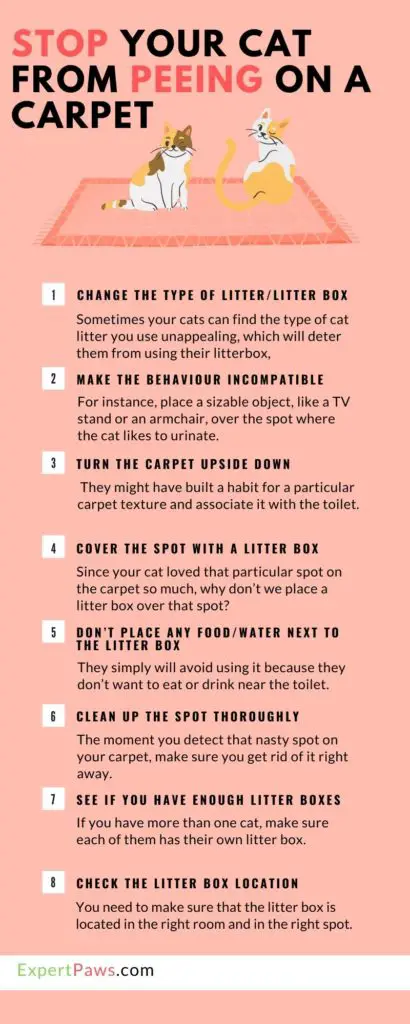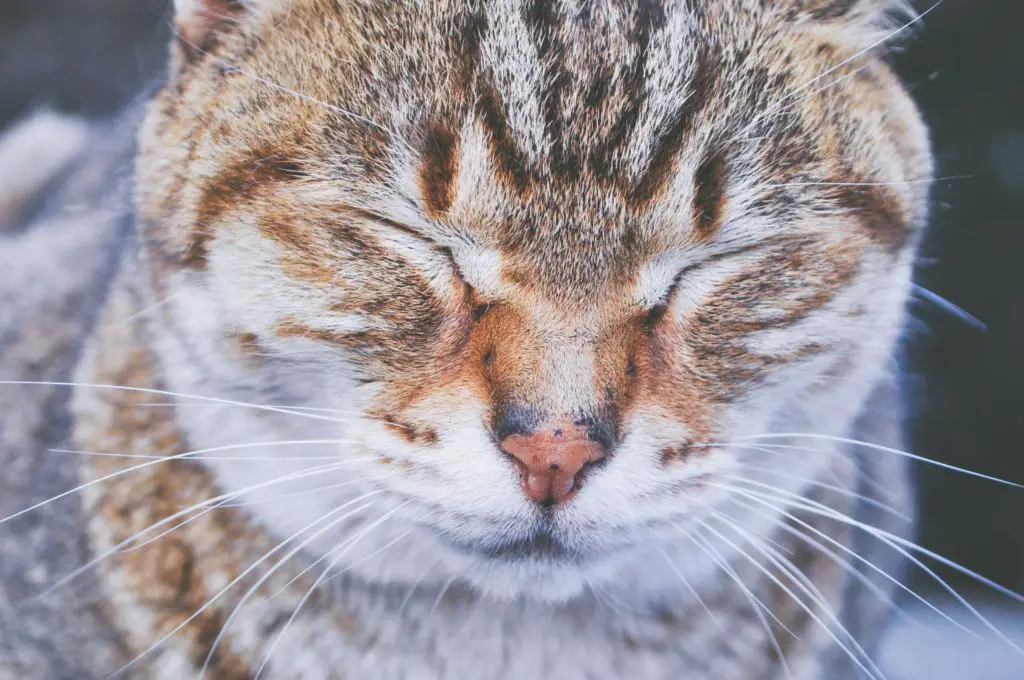It can be very frustrating for cat owners to return home and discover the familiar unpleasant scent of cat urine on their carpets. In some cases, this will happen with mature cats that have used litter boxes before and should know better.
How to stop a cat from urinating on the carpet? Make sure the cat is healthy by going to the vet. Clean the litter box often, make sure it is of the right type and has the right type of cat litter. Don’t place any food/water next to the litter box. Clean the spots thoroughly using an enzymatic cleaner. Try moving the objects around to make the behavior incompatible or cover the spot with a litter box.
So, why is your cat peeing on the carpet and what can you do to stop them? Check out the list of the best Cat Stain & Odor Removers on Amazon now!
Why Is My Cat Peeing On The Carpet All Of A Sudden?
If you come home to find that your cat has urinated on the carpet and this is out of character for them, there could be a medical reason. Something has stopped them from being able to go in the box, perhaps because of poor bladder control or because they were unable to reach the box. Urinary tract infections and kidney issues could be to blame. Take your cat into the vet’s office and let them know what has happened. The sooner you do so, the sooner the problem can be resolved. Also, make sure to mention any other symptoms such as blood in the urine, fatigue, or loss of appetite.
Do Cats Start Urinating Around The House Because Of Stress?
Stress is another common reason why cats end up urinating around the home instead of in the litter tray. You may have spent lots of time training your cat to use a litter box in a certain place and, until now, they have followed through with this every day. But, something may have stressed them out and made them feel unsafe around the box. Or, perhaps the box is in a new location and they aren’t sure about it. It isn’t uncommon for cats to resort to this sort of urination after moving house.

How Do I Get My Cat To Stop Urinating On The Carpet?
The solution here will depend on the cause. Here we will talk about what you can do to stop your cat from urinating on the carpet.
1. Take Your Cat To A Vet
If your cat has a medical issue that requires medication, you may just have to wait it out and encourage them back to the litter tray. Urinary tract infections and kidney issues are some of the most common culprits.
2. See If Your Cat Is Stressed
If the issue is stress-related, you can take the time to consider the location or other issues with the litter box. If you have recently relocated, it might stress the cat and disrupt their toilet routine. In this case, give your cat some time to readjust to the changes. Also, make sure your cat’s litter box is located in a quiet, easily accessible area, for example, a bathroom.
3. Change The Type Of Litter/Litter Box
Sometimes your cats can find the type of cat litter you use unappealing, which will deter them from using their litterbox, What’s more, if you are using an enclosed litter box, try switching it to a regular one. Your cat might not be comfortable with using this particular type of litter boxes.
4. Make The Behaviour Incompatible
This is a technique used by many animal trainers and is working pretty well. You simply need to make it impossible for the cat to urinate in any given spot by making it physically impossible. For instance, place a sizable object, like a TV stand or an armchair, over the spot where the cat likes to urinate. That will help to break the habit provided that the issue is not medical-related.
5. Turn The Carpet Upside Down
This point is closely related to the previous step and is pretty good at breaking the negative behavior pattern. They might have built a habit for a particular carpet texture and associated it with the toilet, so by flipping the rug you might be able to stop this from happening. Try experimenting with the rug for a week or so and see if it works.
6. Cover The Spot With A litter Box
Since your cat loved that particular spot on the carpet so much, why don’t we place a litter box over that spot to make it a legit place for peeing? When your cat gets used to using the litter box( maybe give it a month or so), start slowly moving the litter box to the desired place.
7. Don’t Place Any Food/Water Next To The Litter Box
Cats are renowned for cleaning themselves half of the day. So it’s not surprising that they like the things around them clean. If you place their food or water bowl too close to the litter box, they simply will avoid using the latter because they don’t want to eat or drink near the toilet. Also, make sure you clean the litter box frequently to avoid any unpleasant smells deterring cats from using their litter box.
8. Clean Up The Spot Thoroughly
The moment you detect that nasty spot on your carpet, make sure you get rid of it right away. That will stop your cat from using that spot again. You should use an enzymatic cleaner rather than an ammonia-based one. Ammonia-based cleaners may result in your cat urinating even more often on the spot because it may interpret the ammonia as another cat’s urine that must be covered up because of territorial reasons.
9. Use Cleaning Products
But, if the cat just doesn’t seem to be able to learn not to pee on a carpet, you may need to use some sort of deterrent in your carpet cleaner. A lot of the cleaning products we use have a scent( like citrus or lavender) that will naturally deter cats from even going near a particular spot. We humans like what cats hate, so we can use it to our advantage. Check out the list of the best Cat Stain & Odor Removers on Amazon now!
10. See If You Have Enough Litter Boxes
If you have more than one cat, make sure each of them has its own litter box. Cats don’t like sharing litter boxes and will require a separate litter box that has only their smell.
11. Check The Litter Box Location
Going to the toilet is an intimate process both for us and the cats. So you need to make sure that the litter box is located in the right room and in the right spot. We have a separate article on this topic here.
Related Post:1 Winning Spot To Put Your Cat’s Litter Box In(+ Alternatives)
What Smells Deter Cats From Peeing On The Carpet?
Your cat’s sense of smell could be the answer to your problems here. Cat’s can get a bit fussy about certain smells. You may have noticed this if they have tried new food. There are some fragrances that we love but cats really hate. These include the following:
- citrus scents, such as lemon grapefruit and orange
- lavender
- some other herbal scents such as rosemary
- strong mint scents, such as peppermint
There is a theme here that can work in our favor. A lot of cleaning products and air fresheners will use these scents because they are so appealing to humans. So, you can make a point of spraying your carpets with lavender scents and cleaning them with lemon-scented carpet cleaners. Also, make sure not to use any similar-smelling cleaners around your cat’s litter tray, as this could be counter-productive.
How Can I Make My Cat’s Litter Tray More Appealing To Use?
It isn’t just the smell of the litter box that is important here. Location is vital as cats need to be comfortable going to this location regularly to relieve themselves. You can learn more about where you should put your cat’s litter box here. Ideally, it needs to be somewhere they go often, with enough privacy for them to be comfortable. This may also mean that it is better if they have an enclosed box rather than a tray. Try this out and see if your cat is keener to go to the bathroom there.
Should You Punish Or Correct A Cat For Peeing On The Carpet?
You should never punish your cat for urinating on the carpet. For a start, negative responses to unwelcome behavior aren’t the best way to get results. Also, you may be punishing your cat for something that is out of its control. Either your cat is still peeing around the home because they aren’t fully trained yet – which means your methods are at fault – or because there is something medically wrong with them.
Conclusion
In short, there is a lot to consider here and you need to take a measured response in solving this issue. You can’t get angry at the cat and hope it doesn’t happen again. Instead, you need to consider any medical issues for this change in toilet habits and consult a vet. Then you can help them with their treatments and encourage them back to the litter box. If this is a younger cat that isn’t getting to grips with their training, think about where you are going wrong. Make adaptations to the style or location of the litter box and invest in some safe deterrents. With some patience, you will get things back on track.

My name is Katie, and I have had different pets at home for as long as I can remember. While I can definitely say I love all animals in general, my heart belongs to cats and dogs. I know you are supposed to choose one or the other, but I could never really decide. I’ve also owned hamsters and fish when I was a kid, and they filled my childhood with very delightful memories.





